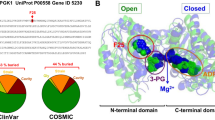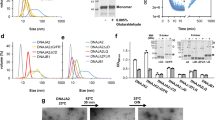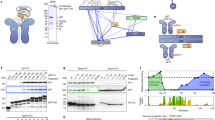Abstract
Crystal structures of active and inactive conformations of the human serine protease HTRA1 reveal that substrate binding to the active site is sufficient to stimulate proteolytic activity. HTRA1 attaches to liposomes, digests misfolded proteins into defined fragments and undergoes substrate-mediated oligomer conversion. In contrast to those of other serine proteases, the PDZ domain of HTRA1 is dispensable for activation or lipid attachment, indicative of different underlying mechanistic features.
This is a preview of subscription content, access via your institution
Access options
Subscribe to this journal
Receive 12 print issues and online access
$189.00 per year
only $15.75 per issue
Buy this article
- Purchase on Springer Link
- Instant access to full article PDF
Prices may be subject to local taxes which are calculated during checkout



Similar content being viewed by others
References
Clausen, T., Southan, C. & Ehrmann, M. Mol. Cell 10, 443–455 (2002).
Perona, J.J. & Craik, C.S. J. Biol. Chem. 272, 29987–29990 (1997).
Krojer, T., Garrido-Franco, M., Huber, R., Ehrmann, M. & Clausen, T. Nature 416, 455–459 (2002).
Hasselblatt, H. et al. Genes Dev. 21, 2659–2670 (2007).
Milner, J.M., Patel, A. & Rowan, A.D. Arthritis Rheum. 58, 3644–3656 (2008).
Chien, J., Campioni, M., Shridhar, V. & Baldi, A. Curr. Cancer Drug Targets 9, 451–468 (2009).
Hara, K. et al. N. Engl. J. Med. 360, 1729–1739 (2009).
Coleman, H.R., Chan, C.C., Ferris, F.L. III & Chew, E.Y. Lancet 372, 1835–1845 (2008).
Grau, S. et al. Proc. Natl. Acad. Sci. USA 102, 6021–6026 (2005).
Hu, S.I. et al. J. Biol. Chem. 273, 34406–34412 (1998).
Wilken, C., Kitzing, K., Kurzbauer, R., Ehrmann, M. & Clausen, T. Cell 117, 483–494 (2004).
Kim, D.Y. et al. J. Biol. Chem. 278, 6543–6551 (2003).
Li, W. et al. Nat. Struct. Biol. 9, 436–441 (2002).
Merdanovic, M. et al. Nat. Struct. Mol. Biol. 17, 837–843 (2010).
Krojer, T., Sawa, J., Huber, R. & Clausen, T. Nat. Struct. Mol. Biol. 17, 844–852 (2010).
Krojer, T. et al. Proc. Natl. Acad. Sci. USA 105, 7702–7707 (2008).
Krojer, T. et al. Nature 453, 885–890 (2008).
Ajayi, F. et al. Am. J. Obstet. Gynecol. 199, 557e1–557e10 (2008).
Meltzer, M. et al. Angew. Chem. Int. Edn Engl. 47, 1332–1334 (2008).
Acknowledgements
We thank D. Hellerschmied for help with biochemical assays. M.E. was supported by the Deutsche Forschungsgemeinschaft and T.C. by ERA-Net NEURON, FWF I 235-B09.
Author information
Authors and Affiliations
Contributions
L.T., A.T., T.M. and F.C. performed experiments; L.T. and T.K. solved the structures; L.T., M.K., T.C. and M.E. planned the experiments and wrote the paper.
Corresponding authors
Ethics declarations
Competing interests
The authors declare no competing financial interests.
Supplementary information
Supplementary Text and Figures
Supplementary Figures 1–4, Supplementary Notes, Supplementary Table 1 and Supplementary Methods (PDF 1620 kb)
Rights and permissions
About this article
Cite this article
Truebestein, L., Tennstaedt, A., Mönig, T. et al. Substrate-induced remodeling of the active site regulates human HTRA1 activity. Nat Struct Mol Biol 18, 386–388 (2011). https://doi.org/10.1038/nsmb.2013
Received:
Accepted:
Published:
Issue Date:
DOI: https://doi.org/10.1038/nsmb.2013
This article is cited by
-
Clinical features and pathogenicity assessment in patients with HTRA1-autosomal dominant disease
Neurological Sciences (2023)
-
Allosteric inhibition of HTRA1 activity by a conformational lock mechanism to treat age-related macular degeneration
Nature Communications (2022)
-
Genotype–phenotype correlations of heterozygous HTRA1-related cerebral small vessel disease: case report and systematic review
neurogenetics (2021)
-
Lysyl oxidases: linking structures and immunity in the tumor microenvironment
Cancer Immunology, Immunotherapy (2020)
-
Two novel heterozygous HTRA1 mutations in two pedigrees with cerebral small vessel disease families
Neurological Sciences (2018)



